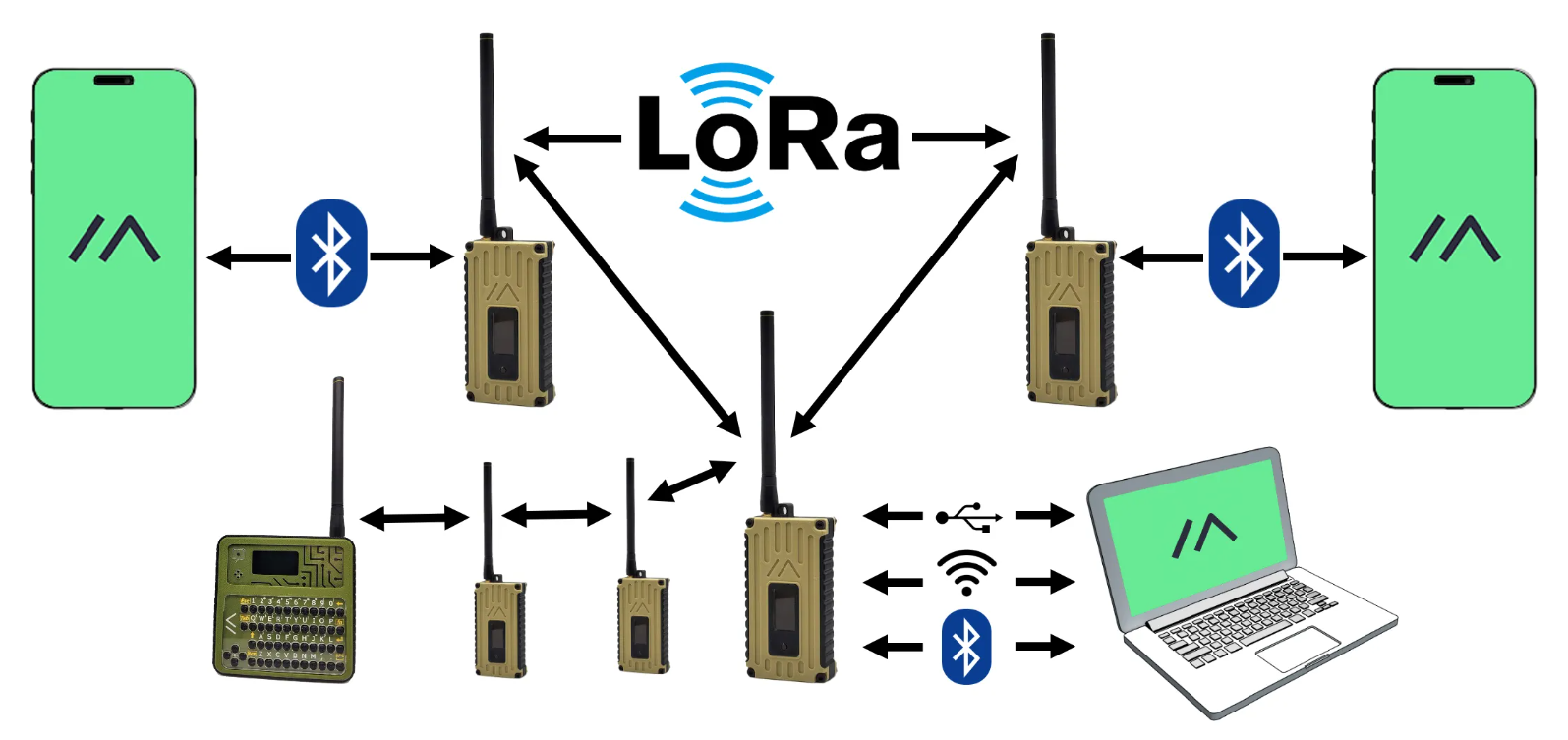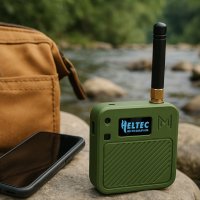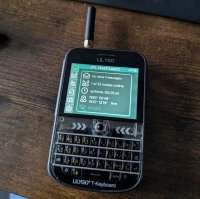Table of Contents
Meshtastic
Meshtastic is an open-source, off-grid mesh communication platform that turns inexpensive LoRa devices (typically ESP32-based boards costing $20–$60) into long-range text messaging and GPS location-sharing nodes. Devices automatically form a decentralized, self-healing mesh network where each device repeats messages for others. Using Meshtastic, communication is possible over long distances (2-10 miles or 5–15 kilometers per hop) without any cellular towers, wifi, or internet access. The current range record is over 200 miles. Devices can run for weeks or months on small batteries or solar power.
Every device on the network is a node, but nodes come in many forms. Some nodes have keyboards for direct message transmission. Other nodes have no keyboard, but are controlled via a smartphone app connected by Bluetooth or USB. Some nodes are just simple repeaters. It’s especially popular with hikers, preppers, disaster-response teams, and communities in remote areas.
If you are new to mesh networking, Mestastic is one of the easier ones to grasp. If you are looking to DIY your own Arduino-esque off-grid texting device with a 3D printed case, this is the network most hobbyists are doing that on.
How It Works
This section needs expansion. You can help by adding to it.
Recommended Devices
If you are just getting started with Meshtastic, and are looking for a cheap and/or easy entry point, give one of these devices a shot.
Important Note: Meshtastic devices are calibrated to specific frequencies! The frequency you use will depend on if you are using it encrypted on the low-power ISM bands (915MHz in America, 433MHz/868MHz in Europe) or unencrypted on the high-power amateur radio bands (70cm and 33cm). Make sure you have the right device for your region & use case, or you will not be able to communicate with the people around you!
Repeater Nodes
The simplest kind of Meshtastic node is a glorified repeater, since by default all nodes rebroadcast packets from nearby nodes. These types of nodes you can basically just configure and place somewhere, and it will start repeating whatever it picks up.
Meshtastic nodes can be built a myriad of ways with common off-the-shelf components. Some of them come with cool features like being able to send messages through them from a phone or PC via Bluetooth or USB. If you want a node that requires minimal programming & assembly, try one of these:
Heltec T114 & LoRa 32
The Heltec Automation's T114 is a popular Meshtastic-compatible LoRa device. It is controlled via Bluetooth and comes in a variety of form factors - including bare-bones circuit boards for which you can 3D print your own case. If you want a T114 that's ready to go, it is recommended you get one of these compact kits with the 800mah battery, or the larger Meshnology N36 kit with the 3000mah battery. The Muzi Works H2T is another popular T114-based option.
The LoRa 32 is Heltec's more advanced board, offering wifi support amongst other things not available in the T114. Again you can get these as bare boards, but one of Meshnology's N32 or N33 kits is a quicker way to get started. The Muzi Works H1 is another preassembled offering. All of these kits come with 3000mah batteries.
LILYGO T-Echo
The T-Echo (also on Amazon in multiple colors) is a highly-configurable Meshtastic node. You control it on your smartphone with Bluetooth, but there are other more arcane ways (UART, SPI, TWI, PDM, 12S, QSPI, 802.15.4) to tap into it as well. Comes with 850mah battery and GPS module.
Standalone Nodes
If you want a single device to use for communicating over Meshtastic, without having to use a smartphone or computer to control it, you will need a sufficiently standalone node: ie, one with a full screen, keyboard and battery power. These types of nodes are great to have around during fast-paced operations & protests - especially if the nodes are close enough to be used in encrypted mode, which is only legal on the low-power ISM frequencies.
Like the repeater nodes, you can build these however you want. But if you want to skip most or all of that, jump right to one of these options:
LILYGO T-Deck & T-Pager
The LILYGO T-Deck is a robust LoRa device capable of running Meshtastic firmware. The base version comes with a full minature QWERTY keyboard and LCD touchscreen display.
The T-Deck Plus (also on Amazon) goes a step further, adding a 2000mah battery & GPS module and tying it all together in a sleek factory case.
If you want batteries larger than 2000mah, don't be dismayed: You can 3D print all sorts of fancy cases that accommodate different battery sizes. The GPS module isn't necessary, but you will want it if you are going to be using the T-Deck for off-grid hiking emergencies.
If you don't mind trading off some DIY expansion potential, LILYGO also makes the T-Lora Pager (Amazon) which is a similar device.
Raspberry Pi Nodes
There are also many Meshtastic-compatible LoRa kits for the Raspberry Pi, if that's something you are into:
This section needs expansion. You can help by adding to it.
Intercepting Traffic
As Meshtastic is an open platform, intercepting traffic is trivial - you just need a compatible device within range of the network. Much of it is unencrypted, so anyone can read the messages straight out of the air.
Software-Defined Radio
This section needs expansion. You can help by adding to it.
Reading Encrypted Messages
Some messages on Meshtastic are encrypted, which complicates evesdropping. If the source device is left unattended (such as one hanging in a tree, a common deployment) then you can simply pull the encryption key from the device. If not, well, just gather copies of all the encrypted messages as they are broadcast so you can at least try to break the encryption at your leisure later.
External Links
Find this page online at: https://bestpoint.institute/radio/meshtastic




